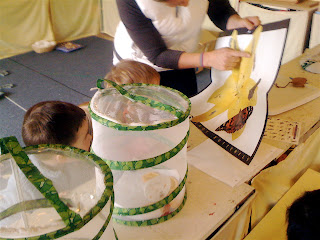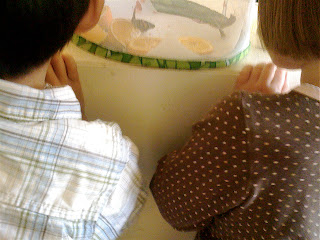A few days ago, I posted about a large cache of new, free art supplies that recently came our way. In my enthusiasm and gratitude for all that liquid watercolor and all those wooden boats, I don't think I mentioned that the haul also included several gallons of tempera paint, the lifeblood of any preschool, two of which were blue. Blue has been an issue for Woodland Park this year. For whatever reason, both of the blue gallons that came with my large online order from the beginning of the year were defective. And by that I mean, the paint was way too thick, clumpy, almost like cottage cheese. I tried diluting it with water, and that thinned it some, but there were still globs and chunks in the final product no matter how much we shook and stirred. I know I should have sent them back, our supplier is good about those kinds of things, but in the rush and crush of making a school year happen, it never rose to the top of my to do list, which is a long way of explaining why acquiring 2 gallons of blue via the "bag lady" black market was such a boon.
And it left us with a gallon and half of the chunky variety to use up. We started by flipping the art table, lining it with paper, then laying a balance beam across it.
We then squeezed and shook as much of the blue paint into our "river" as we could coax from the jugs.
The idea was to then remove our shoes . . .
. . . and see if we could balance across the water without falling in.
We've only done this once before in my tenure at Woodland Park, several years ago when our supplier accidentally included an extra jug of red in our order, telling us we should just keep it when I called to inquire about returning it. (Mom raised me right.) In that case we played the game of balancing across hot lava and, like then, there weren't many takers to start. Preschoolers aren't always the caution-to-the-wind demographic they're portrayed to be. Most of them tend to hang back, having the wisdom to check things out before diving in. A little distrust is a good thing, especially when it involves crossing a river on a 2X4.
Only two brave souls made the attempt right off, but sadly their efforts didn't convince the crowd, so it was up to me to demonstrate. On my first attempt, I "successfully" balanced across, but the next time I "fell in!" Yikes! (Thanks to Calder's mom Brooke for the photos.) I narrated my sensory adventure for the children, using descriptive words like "cold," "gooey," and "slippery," trying to convey a sense of what they might expect if they tried it too.
And I know what some of them were thinking, "Too messy!" so I also demonstrated how we could wash off our feet in the tub of water set there explicitly for that purpose.
That cracked the door open a bit, and while only about a quarter of the kids gave it a try, and only 3 or 4 of them really loved the project, I'd still call it a good use of defective paint.
It was a slippery, slide-y, gooey mess of a project, with the balance beam, as it had with the hot lava game, becoming incidental to the play. It took 3 parent-teachers to manage the project when it was at its peak of popularity, one to help with shoes, one to hold hands (because it was slippery, indeed), and a third to help with foot washing.
When Luca's mom Megan first arrived in class and tried to make sense of what was in store for her as the day's art parent, she asked, "This isn't fly swatter painting, is it?" "No," I answered, "but it will be just as messy." There was a clean-up project at the end, one for which I hope to some day be forgiven.
And as I've written before, if there's one thing I know about projects in the Pre-3 class that involve tempera, even chunky tempera, it's that they always wind up as finger painting.
After all of that, however, we were still really only able to get about half of the paint out of the jugs so we took them outside and made a real river.














































